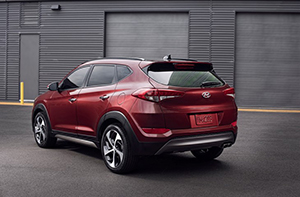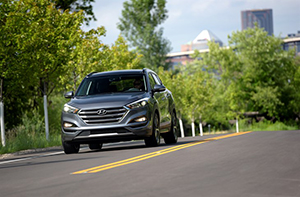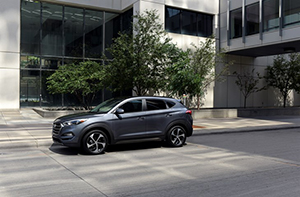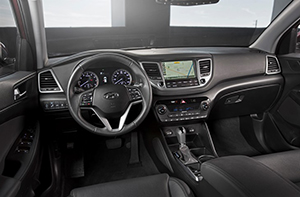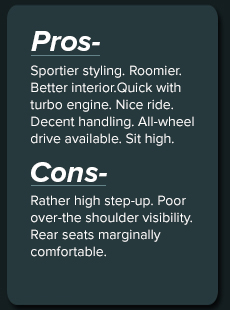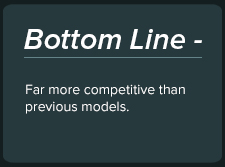2016 Hyundai Tucson
The Hyundai Tucson is much improved for 2016.
Prices: $22,700-$32,300
Much improved in most respects, the redesigned 2016 Hyundai Tucson puts
its predecessors in the weeds.
The Tucson has been popular, partly because many vehicle buyers are
opting for smaller SUVs and crossover vehicles instead of cars. But the
new Tucson is far better equipped to compete with popular competitors
such as the Toyota RAV4 and Honda CR-V.
The new Tucson is a compact four-door hatchback SUV that starts at
$22,700 and goes to $31,300 for the top-line Limited all-wheel drive
(AWD) model I tested. This new Hyundai comes with front-drive or
AWD.
The base SE front-drive model has a 2-liter four-cylinder engine with
164 horsepower and 151 pound-feet of torque and works with a six-speed
automatic transmission. Eco, Sport and Limited models offer the new
1.6-liter turbocharged four-cylinder with 175 horsepower and 195
pound-feet of torque. Peak torque delivery starts at only 1,500 r.p.m.
and holds through 4,500 r.p.m. for low-r.p.m. responsiveness and
performance during everyday driving.
My test Tucson had the turbo engine. It works with a new seven-speed
dual-clutch transmission, which offers good efficiency with quick,
seamless shifting and helps provide brisk acceleration. Its responsive
manual-shift feature is controlled by the console shifter.
Passing times of 65-75 m.p.h. are quick, at least with just a driver
aboard, although the generally smooth, quiet engine gets rather loud
under full-throttle acceleration. My test Tucson's engine loafed at
2,000 r.p.m. at 65 m.p.h.
Estimated fuel economy depends on the engine and drive setup. The
economy figures can make you dizzy, ranging from 23-26
miles per gallon in the city and 31-33 on highways with front-drive.
AWD lowers the figures to 21-25 city and 26-31 highway. My test Limited
AWD's price sticker gave economy figures of 24 city and 28
highway.
Besides sportier styling with better aerodynamics, the new Tucson has a
1.2-inch longer wheelbase for better ride comfort and linear stability.
It's width also has been increased more than one inch.
Some people judge a vehicle's quality by how a door sounds when closed.
To encourage potential Tucson buyers, Hyundai has extensively refined
the door latch mechanisms, with lower noise, pull resistance, internal
friction and good closure damping.
Many important improvements have been made under the "skin." For
instance, the chassis is more rigid, using more than 50 percent
advanced high-strength steel, compared with 18 percent for the former
model.There's also reduced noise levels and ride and handling
improvements.
It takes a little extra effort to enter the Tucson, but occupants sit
high for a good view of surroundings.
The deftly redesigned interior has easily read backlit gauges and
a mixture of large and small controls that are clearly marked. The
interior is markedly quieter, thanks to more use of sound insulation
materials and improved aerodynamics.
My test Limited's power front seats offered good support in curves, and
a thoughtful item is a stitched, soft-touch pad near the driver's right
knee for more comfort during long commutes. Another nice touch is a
large floor support for a driver's left foot during long drives.
An available full-length panoramic sunroof allows front/rear
passengers skyward visibility, although my test Tucson's rear
seats were only marginally comfortable. They reclined, but were rather
firm and needed more thigh support.
At least there finally is decent room back there for two tall adults. A
fold-down rear center armrest contains two cupholders.
The hatch's automatic open/close feature can be controlled by a
dashboard button. Also, this "Smart Power Liftgate" lets a Tucson owner
automatically open the hatch hands-free by just standing within a few
feet of the hatch for a few seconds with the key fob in a pocket or
purse. The hands-free tailgate is standard on Sport and Limited models.
The hatch opens to reveal a large cargo area, which can be greatly
increased by folding the rear seatbacks forward.
The front console contains easily reached dual cupholders and a deep
covered storage bin. Also, all doors have decent storage/beverage
container pockets.
Worthwhile available options for some models include a lane departure
warning system, blind-spot detection, rear cross-traffic alert, lane
change assist, backup warning sensors and automatic emergency braking.
The lane-change assist is particularly helpful because
over-the-shoulder visibility for a driver is poor. At least the fold-in
rearview mirrors are decently sized.
My test Tucson Limited had electronic stability and traction controls
and electronic brake force distribution for its 4-wheel disc brakes.
Those features and 45-series tires on 19-inch alloy wheels, along with
a suspension enhanced for more precise handling, helped result in good
roadability for a rather tall vehicle.
The motor-driven power steering was quick, but initially felt rather
light in town. The brake pedal had a nice linear action.
The ride was smooth. Despite its sportier styling, the new Tucson is
designed primarily for comfort and efficiency.
The AWD system includes a driver-selectable AWD lock that allows a
differentiated torque split between front and rear wheels for off-road
and extremely slippery road conditions. The system also reduces
understeer and enhances cornering performance.
My Limited's standard items included these comfort and convenience
features: push-button starter, leather-covered seats, power door locks
and windows, dual automatic temperature control, heated side mirrors,
tilt/telescopic wheel, 8-inch touchscreen navigation system with
rearview camera, AM/FM/MP3 premium audio system, blind-spot detection
system with rear cross-traffic alert and lane-change assist.
It even had a fairly large rear roof-mounted spoiler and twin bevel-cut
chrome exhaust tips.
Safety features include front, front side and side curtain air bags and
rollover sensors.
The 2016 Tucson arrives at just the right time to cash in on the
growing compact SUV/crossover market.


